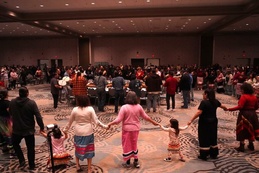'Tourist Train' Could Be Just a Few Years Away
For $1.7 million, a tourist train could once again chuff back and forth from Traverse City to Williamsburg.
June 30, 2014
That’s according to a report due out July 19 from the Michigan Land Use Institute. The report calls on community leaders to raise the money and create an organization to make a seasonal train a reality.
The MLUI report finds that a train could grow tourism from Traverse City to Acme to Turtle Creek, that it could spur revitalization of Eighth St. near the depot in Traverse City, and that it could be an impetus to establish year-round commuter rail.
NEXT STOP: DOWNSTATE
The experiment could someday lead to something even more significant – a rail link between Traverse City and downstate, said James Bruckbauer, transportation policy specialist for MLUI.
The tracks from Traverse City to Williamsburg and the tracks between Traverse City and Ann Arbor are owned by the state and leased to Great Lakes Central Railroad.
The railroad is focused on developing freight business but long-term would like to carry passengers, Bruckbauer said. He said Great Lakes has cooperated with the Traverse City tourist train study and has accommodated excursion trains elsewhere.
LOTS OF WORK AHEAD
The 11-mile stretch of track in question is seldom used and is barely in good enough condition to carry freight. The tracks are maintained at the lowest standard allowed by the Federal Railroad Administration and trains are forbidden to carry passengers or travel more than 10 miles per hour.
The MLUI report estimates the tracks could be converted for use as a seasonal passenger line for $1.7 million. Bruckbauer said that might sound like a lot until you compare it to the state’s estimate of $9 million to reconstruct 1.5 miles of US 31 in the same corridor.
The cost to operate the line could range from millions per year for a year-round commuter train to around $100,000 for a seasonal, weekend-only tourist train.
"˜AN ACHIEVABLE FIRST STEP’
The report focuses on the scaled-down vision of a tourist train that would run during warm weather because that option costs so much less than alternatives, Bruckbauer said.
First, the cost to upgrade tracks to handle a seasonal tourist train is scant compared to what the Federal Railroad Administration requires of commuter rail lines.
Second, by limiting the project to a train that operates only in the summer months, costs go down drastically, Bruckbauer said.
If the train doesn’t run in the winter, that means tracks don’t have to be kept clear of snow and engines and cars don’t have to be stored on freezing nights.
"It’s an achievable first step, to have a service that focuses on how do we get visitors back and forth between the two areas," he said. "And then as demand grows and interest grows from that, we should start looking at expanding it to year-round commuter rail."
MUCH IS UNCERTAIN
Bruckbauer believes the service will mainly appeal to tourists staying in Williamsburg, Acme or in hotels along East Bay who want to visit Traverse City for an afternoon and not worry about a car.
It could also appeal to tourists or residents in Traverse City who want to visit Acme or the Turtle Creek Casino.
"I think it will work both ways, but I see more interest primarily from people who are coming from the east and heading into Traverse City," Bruckbauer said.
The MLUI study intentionally leaves many questions unanswered.
For instance, whether the line would run as an express between Traverse City and Williamsburg or whether and how many stops there would be along the way is left open.
Also left open is whether the plan would involve an actual train engine pulling a passenger car. The tourist train could run as a trolley modified to run on train tracks.
The report recommends that community leaders seek a combination of public and private funding. It suggests alternatives for setting up an organization to run the train and outlines small rail projects around the country that are run by an existing transit agency, a nonprofit, or a private company.
QUESTIONS IN ACME
Acme Township Supervisor Jay Zollinger said he’s not sure how much a train would mean for people who wanted to visit the township’s bayfront park or the village center development, a long-debated project that includes a Meijer store at its center.
He said the tracks are about a quarter mile from either of those places, limiting the usefulness of a train for beachgoers or shoppers.
Zollinger said he will keep an open mind about it, however. He said he thinks it could be a good thing as long as it can pay for itself.
"I think we have to give the study a chance so we can see what the outcome is," Zollinger said.
Denny Rohn, president of the Concerned Citizens for Acme Township, said her organization was a sponsor of the study because they support smart growth and reducing traffic.
"From a regional and environmental standpoint, we like the idea of mass transit," Rohn said. "I think if we can come up with smart transportation that works for a lot of people versus everyone of these people driving a car, I think that makes a lot of sense."
The report is scheduled to be released at a reception July 19 at the Filling Station at The Depot in Traverse City. It will be available to view online through the Michigan Land Use Institute’s website.
Trending

Our Top Stories of 2025
Each year, we look back at the stories we’ve shared over the last 12 months and pull together the ones that got the mo… Read More >>
A Solo Rattler
Frontman of folk-rock band Michigan Rattlers Graham Young brings his solo performance to Great Lakes Center for the Arts in … Read More >>
GTB Starting the Year with Tradition
The Grand Traverse Band of Ottawa and Chippewa Indians hosts the Kchi Wiikwedong Anishinaabek Maawnjidowin Round Dance on Ja… Read More >>


